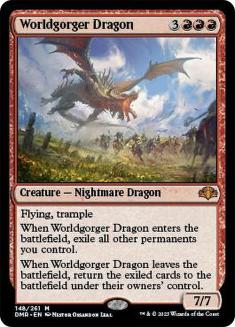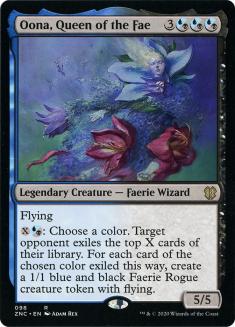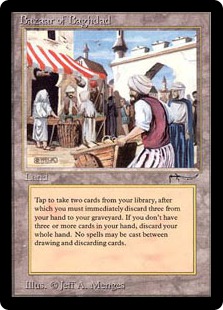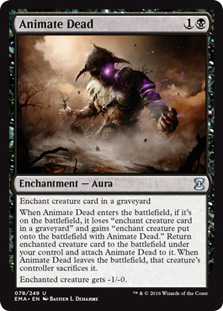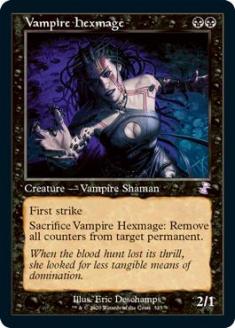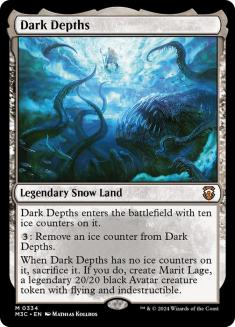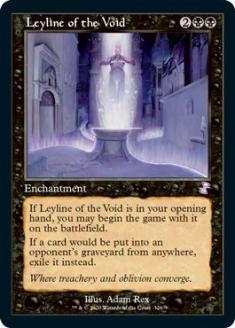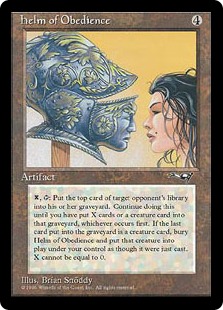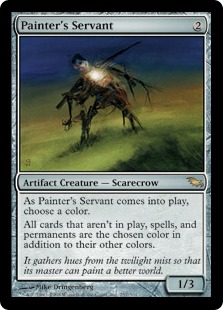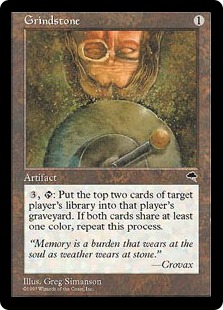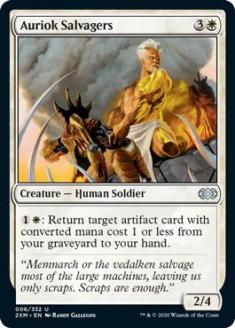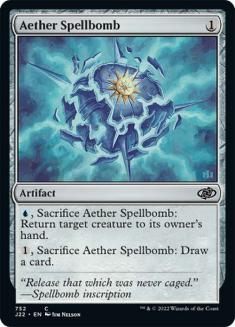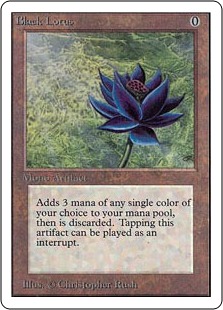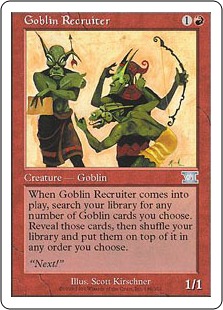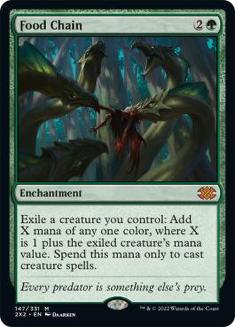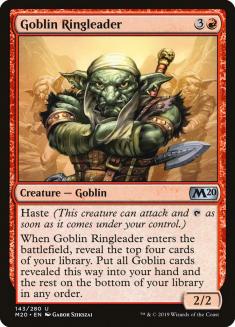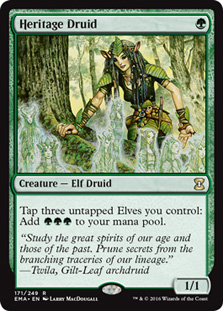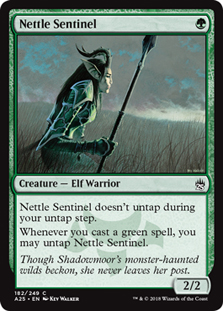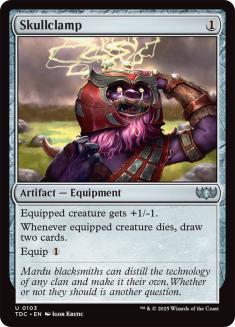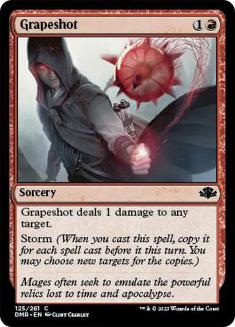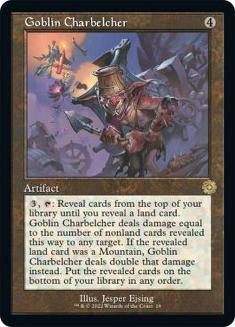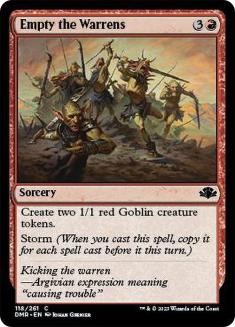Last article I presented a lot of unique decks and cards that are run in Vintage. Like my last article, I wanted to stick with that same general theme and present to you the combo decks that aren’t necessarily part of the mainstream and are off the beaten path. As always, the decks I present to you today all have top 8 credentials, except one which finished 9th, further proving the point the modern Vintage metagame is just as wide open as it’s ever been.
When most people think combo in Vintage, a lot of the preconceived notions is that it involves one of the following:
While they are indeed part of Vintage, they make up just a handful of game-winning combos you can use to win the game in Vintage. What we will go over here today is the rest of Vintage’s combo decks. By the end of the article, I am sure that you will be able to notice that there are many different flavors of combos in Vintage and not just your typical ones I listed above.
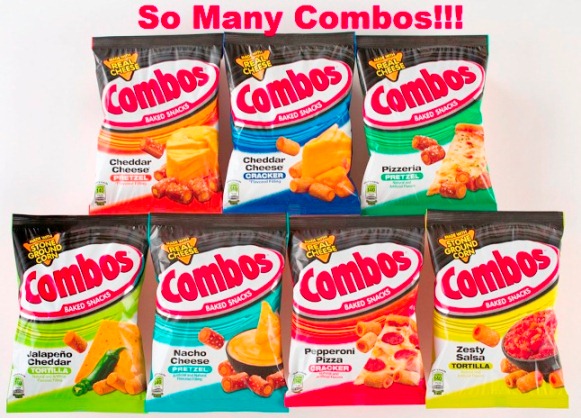
“Minus 6”
Creatures (8)
Lands (18)
Spells (34)
- 1 Sensei's Divining Top
- 1 Brainstorm
- 1 Vampiric Tutor
- 4 Duress
- 4 Force of Will
- 2 Dance of the Dead
- 2 Animate Dead
- 1 Sol Ring
- 1 Demonic Tutor
- 1 Time Walk
- 1 Ancestral Recall
- 1 Imperial Seal
- 1 Mana Crypt
- 1 Necromancy
- 2 Intuition
- 2 Read the Runes
- 1 Thirst for Knowledge
- 1 Echoing Truth
- 1 Black Lotus
- 1 Mox Emerald
- 1 Mox Jet
- 1 Mox Pearl
- 1 Mox Ruby
- 1 Mox Sapphire

Here we have probably my favorite deck in this article, Minus 6 aka Worldgorger Dragon Combo. Worldgorger Dragon combo has been in Vintage for a long time, but this is a rebooted version of a classic favorite. Originally developed by Chris Browne in 2009, the deck has gained some major headway since being picked up by pilots Nick Coss and Jake Gans. Surprisingly the only changes the maindeck has seen from the deck’s origin to Nick Coss’s Vintage Champs top 8 lists has been -1 Necromancy -1 Merchant Scroll +1 Dance of the Dead +1 Imperial Seal. Minus 6 has really been able to stand the test of time, as evidenced from its numerous top 8s and wins Nick and Jake have both picked up with the deck since 2009, culminating with its recent Vintage Champs top 8.
How it Works:
The deck looks to reanimate Worldgorger Dragon via a permanent-based enchantment (Dance of the Dead, Animate Dead, and Necromancy); when this happens you can then put Worldgorger Dragon’s come-into-play effect on the stack. If you have any available mana here, add it to your mana pool; if not we let Worldgorger’s ability resolve, which removes all OTHER (which is key) permanents we control from play. Since Worldgorger is stuck on the battlefield himself and not attached to its reanimation enchantment, it dies, which triggers Worldgorger’s other ability when it dies, to bring everything back into play untapped (which is key). Once this happens you can then target Worldgorger Dragon with the reanimation enchantment, add all of your freshly untapped mana to your mana pool and repeat to generate “infinite mana.” Before we get to killing our opponent with the combo, I want to stress a key point here. If you find yourself in an unwinnable situation, such as your opponent is going to kill you with Blightsteel Colossus, has an active Oath of Druids, staring you down with a Zombie hoard, etc., as long as there are ZERO OTHER LEGAL targets for your reanimation enchantment you can effectively draw the game due to the loop going infinitely because you are unable to stop it. This is a perfectly fine line of play and emergency outlet; go for the combo and the draw if you are unable to win and are facing a lethal or a near lethal board state from your opponent.


Anyway let’s look at how we are actually going to kill our opponents. While looping our Worldgorger and generating “infinite mana,” we have a couple of ways to get to a lethal situation; they all revolve around getting Oona, Queen of the Fae and using our “infinite mana” to exile their library with Oona’s ability. Choosing a color doesn’t matter since we are looking to one-shot their entire library. Below are the key cards and ways to get Oona in your graveyard in order to reanimate her and end the loop.Â
If you have Intuition while you are combo-ing off, you can resolve an Intuition in-between one of your loops. Get Dark Confidant, Dark Confidant, and Oona, Queen of the Fae if it resolves; if they give you a Dark Confidant, you can just end the loop with Oona and kill them. If they give you Oona, you can end the loop with Dark Confidant and hard cast and activate Oona to kill them.
If you have Read the Runes while you are combo-ing off, you can use some of your “infinite mana” to Read the Runes through your entire deck and then discard it, which should include Oona, which will then allow you to end the loop with her and kill your opponent. Another nice thing about Read the Runes is that it allows you to sacrifice a Dark Confidant or Mana Crypt if you are close to dying from them.
This is generally the way you will find Oona. If you have Bazaar of Baghdad on board while you are combo-ing, you can activate Bazaar in-between each loop to mill yourself until you find Oona to reanimate.Â
What’s very unique about this deck is that it is equipped with a fully transformational sideboard into a traditional blue control deck. You can even sideboard into a hybrid, with all three combos in the deck (Worldgorger, Blightteel, and Time Vault/Voltaic Key). When sideboarding you want to shuffle in all 15 every time, to add to the mind games of which deck they will be playing in game 2/3. There isn’t necessarily a correct time to make the full, partial, or no transformation, but generally game three works best, especially if you don’t transform for game two and they look to bring in Leyline of the Void or Tormod’s Crypt or similar effects for game three. For the most part it is based on mind games with your opponent, unless it’s Dredge, in which case you probably want all of your combos in.
Full Transform:
+ Your entire sideboard
-2 Animate Dead
-2 Dance of the Dead
-1 Necromancy
-3 Worldgorger Dragon
-1 Oona, Queen of the Fae
-4 Bazaar of Baghdad
-1 Read the Runes
-1 Intuition
Partial Transform:
-4Â Duress
-1Â Read the Runes
-1Â Island
+1Â Tinker
+1Â Blightsteel Colossus
+1Â Time Vault
+1Â Voltaic Key
+1Â Gifts Ungiven
+1Â Tolarian Academy
Dark Times
The Council Open #11 – TPG – Bloomsburg, PA – 11/26/11
Semi-Finalist — Brienne Pope
Creatures (8)
Planeswalkers (1)
Lands (19)
Spells (32)

The Council Open #8 – TPG – Bloomsburg, PA – 8/20/11 Â
Creatures (8)
Lands (20)
Spells (32)

8. Furrer Thomas
Swiss Vintage League 11.13.2011
Â
Creatures (16)
Lands (21)
Spells (23)
- 1 Vampiric Tutor
- 1 Yawgmoth's Will
- 3 Diabolic Edict
- 1 Necropotence
- 1 Demonic Tutor
- 4 Dark Ritual
- 1 Imperial Seal
- 1 Demonic Consultation
- 1 Black Lotus
- 1 Mox Jet
- 4 Thoughtseize
- 4 Mental Misstep
Sideboard

Back in January of 2010 Max Brown won the first Blue Bell Game Day event ran by Nick Coss with a little known brew at the time, which would go on to be known as Dark Times. He strolled through a very blue and Dredge heavy field piloting his own mono-black creation. Relying on a mix of heavy hand disruption, mana denial tactics, and two-card combos, he was able to enjoy very favorable winning percentages against the blue and Dredge heavy field. His two-card combos weren’t the usual Time Vault/Voltaic Key or Tinker/Bot, however were equally backbreaking and pretty much win the game when they are assembled.
Dark Times is a very unusual deck to classify; just by looking at the lists we can see a lot of different potential strategies and cards the deck uses. We have aggro and mana denial (Fish type strategies) as well as Dark Ritual fueled combo lines of play. For this article series I chose to include Dark Times in the combo section here and not in either the Dark Ritual or Fish classifications. I did this because I felt the core of the deck was based on its combos, and in most games the deck does not operate like a Fish or Dark Ritual deck.Â
How it Works:
The most basic version of the deck contains two combos in the maindeck: Vampire Hexmage/Dark Depths and Leyline of the Void / Helm of Obedience.
Vampire Hexmage / Dark Depths
Vampire Hexmage lets you remove all the counters from your Dark Depths for the cost of two black mana and a vampire sacrifice, which is going to net you Marit Lage, a 20/20 token that is indestructible and has flying. One of the keys to the deck is to do this at the end of your opponent’s turn to avoid any shenanigans they might be able to do to get rid of your Marit Lage token such as bouncing it with Jace, the Mind Sculptor. Basically you are Tinkering into your own one-shot Blightsteel Colossus; however there are significantly fewer outs to this “Colossi.” For most decks in the format, Jace is going to be their only out to a 20/20 flying, indestructible token. Another key is you always want to resolve a Vampire Hexmage before you play a Dark Depths if you can; they can’t counter you playing a Dark Depths. The nice thing about Vampire Hexmage is that she can hold down the fort against opposing X/2 or less creatures until you get a Dark Depths, and she can kill opposing Jaces.
Leyline of the Void / Helm of Obedience
Leyline of the Void in the maindeck is pretty backbreaking to a lot of decks, particularly Dredge and Minus 6. Leyline of the Void can pull its weight across multiple matchups though, from shutting down a Crucible of World/Strip Mine or Wasteland lock, nullifying Goblin Welder, turning Yawgmoth’s Will into a dead card, blanking any recursion strategies an Oath of Druids deck might have, to even slowing down the growth of Tarmogoyf. With a Leyline of the Void in play, Helm of Obedience’s activation will effectively mill your opponent’s entire deck since none of the cards will be going to the graveyard.
The first two lists I have are pretty straightforward and maintain the deck’s original nucleus. The first list has more of the traditional mono-black Dark Times core with some exciting new additions from the two newest Magic sets. The second list splashes green, which gives it access to Sylvan Library, Pernicious Deed, and some cheap artifact removal. The green splash helps compensate for the deck’s traditionally poor Mishra’s Workshop matchup, with Pernicious Deed essentially taking the roll and functionality of Null Rod for this build. The third list is pretty big deviation from the Dark Times lists of the past.
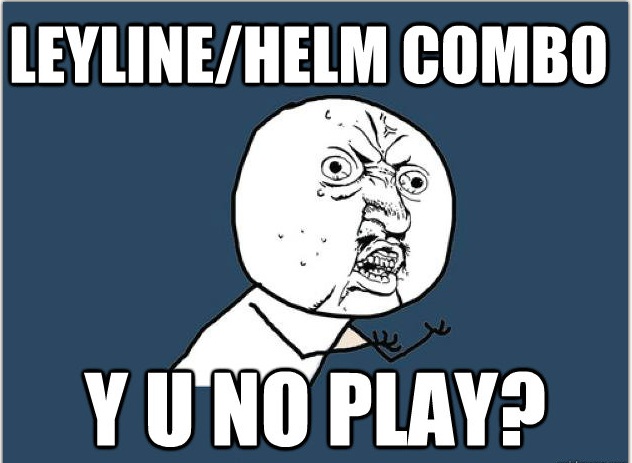
Forgoing maindeck Leyline of the Void and cutting Helm of Obedience altogether, the third list looks to utilize the synergy of Hex Parasite and Death’s Shadow. Not necessarily a game-winning combo, it can apply a significantly fast clock to your opponent. The object is to use Hex Parasite’s ability, via paying two life for the Phyrexian mana requirement, to grow your Death’s Shadow as big as possible. You also have some natural life losing synergies in the deck with Dark Confidant and Thoughtseize. Despite losing the advantages I mentioned from having maindeck Leyline of the Void, Hex Parasite provides an excellent answer to Jace, the Mind Sculptor, Tangle Wire, Smokestack, and even an additional way to remove counters from your Dark Depths.
Painter
Painter, by Joseph Brown — 7th place- 2011 Vintage Champs
Creatures (5)
Planeswalkers (2)
Lands (16)
Spells (38)
- 1 Brainstorm
- 2 Mana Drain
- 1 Vampiric Tutor
- 1 Mystical Tutor
- 1 Yawgmoth's Will
- 4 Force of Will
- 2 Grindstone
- 1 Sol Ring
- 1 Demonic Tutor
- 1 Hurkyl's Recall
- 1 Time Walk
- 1 Ancestral Recall
- 2 Red Elemental Blast
- 1 Mana Crypt
- 1 Gush
- 1 Timetwister
- 1 Merchant Scroll
- 1 Thirst for Knowledge
- 2 Pyroblast
- 3 Mystic Remora
- 1 Tinker
- 1 Black Lotus
- 1 Mox Emerald
- 1 Mox Jet
- 1 Mox Ruby
- 1 Mox Sapphire
- 3 Mindbreak Trap

T1 Frankfurt, 11.06.2011 Â
4th. Martin Pfeifer
Creatures (9)
Planeswalkers (2)
Lands (16)
Spells (33)
- 1 Sensei's Divining Top
- 1 Brainstorm
- 3 Mana Drain
- 1 Vampiric Tutor
- 1 Mystical Tutor
- 1 Yawgmoth's Will
- 4 Force of Will
- 2 Grindstone
- 1 Sol Ring
- 1 Demonic Tutor
- 1 Hurkyl's Recall
- 1 Time Walk
- 1 Ancestral Recall
- 2 Red Elemental Blast
- 1 Mana Crypt
- 1 Merchant Scroll
- 1 Thirst for Knowledge
- 1 Pyroblast
- 1 Tinker
- 1 Black Lotus
- 1 Mox Emerald
- 1 Mox Jet
- 1 Mox Pearl
- 1 Mox Ruby
- 1 Mox Sapphire
- 1 Engineered Explosives

Swiss Vintage League 10.09.2011
2nd Christian Scheuber – MonoR Painter
Creatures (20)
Lands (17)
Spells (24)

How it Works:
Painter’s Servant names a color; for the most part you name blue, although there are certainly times when you will name a different color. Since Painter’s Servant turns every card in the game blue (or whichever color you choose), a Grindstone activation targeting your opponent mills their entire library, and the process keeps repeating due to the fact that every card is now that one color you named.
The reason you traditionally name blue is that it is most advantageous to the cards you are already playing. With maindeck Red Elemental Blast / Pyroblast, having a Painter’s Servant on board naming blue allows you to counter any spell played or even destroy ANY permanent in play with either of those cards. It also allows you to pitch ANY card in your deck, EVEN LANDS, to help pay the alternate cost of Force of Will. There will be some instances where you don’t won’t name blue however, such as if you know your opponent is running Red Elemental Blast/Pyroblast and/or Force of Will themselves. Â
Painter’s Servant-based combo decks are unique in that they don’t operate and feel like a combo deck within the scope of Vintage. Their game plan and execution falls more in line with control decks, except in the case of the mono-red version, which I will discuss in a bit. The two blue-based versions I posted of the deck are set up very similarly despite some of the differences in card choice.
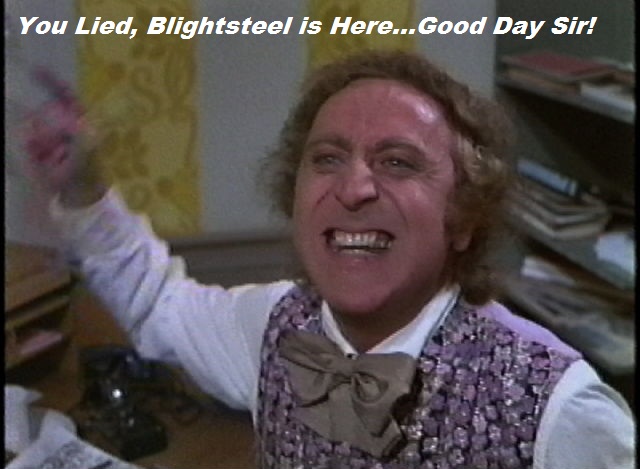
Both contain much of the restricted list, Red Elemental Blast/Pyroblast, Tinker/Blightteel, and a card draw engine in addition to the Painter’s Servant combo. It is a pretty obvious call to include Blightsteel Colossus; you are already going to include Tinker, as it tutors for either piece of the deck’s primary combo (Painter’s Servant/ Grindstone); why not include an additional win condition at the cost of one spot in your deck?
The engines powering the first two lists are very different. Joe decided to go with Mystic Remora paired with a heavier counterspell package while Martin’s list looks to utilize Dark Confidant and Trinket Mage to get the deck card advantage. Joe’s setup is more geared towards beating decks that play non-creature spells (Blue decks, Storm, non-creature combo, etc.) while Martin’s Trinket Mage package allows him to be more versatile in an open field.
The mono-red version of Painter I have listed operates with a more fish-style game plan. The deck is joined with an aggressive creature and mana denial package with a very interesting alternative combo, Storm Entity. Forgoing any real draw power the deck maximizes the Grindstone and Painter’s Servant count, and to win counter wars the deck relies on Goblin Welder to essentially buy back a part of the combo if it is countered or destroyed. The deck can also try to utilize its fast mana package (Rite of Flame, Simian Spirit Guide, and artifact mana) to drop a nice-sized Storm Entity on board to put a fast clock on their opponent. Fanning out a reasonable seven such as Rite of Flame, Storm Entity, Mox Ruby, Chalice of the Void, Mountain, Pyroblast, Grindstone will let you drop a 5/5 haste creature into play turn one with some disruption and potential backup:
- Play Mountain
- Play Mox Ruby (Storm Entity Count- 1)
- Tap Mox Ruby play Rite of Flame (Storm Entity Count- 2, RR in Mana Pool)
- Play Grindstone (Storm Entity Count- 3, R in Mana Pool)
- Play Chalice of the Void for zero (Storm Entity Count- 4, R in Mana Pool)
- Tap Mountain, use R in Mana Pool, play Storm Entity, comes into play with four +1/+1 counters, attack for five.
There are a few ways to play that hand; maybe you make it a 4/4 and not play Grindstone to have Pyroblast available if they counter it, but the main point I want to illustrate here is Pyroblast vs. Red Elemental Blast and why it matters for this deck.
Obviously you are going to want your Storm Entity to be big if possible, and the decision to maindeck strictly Pyroblasts reflects that. Pyroblast allows you to target ANY permanent OR spell, blue or not, but will only counter/destroy the spell if it is actually blue. Pyroblast doesn’t check for the spell’s/permanent’s color until resolution. This allows you the added flexibility to potentially burn it up just to generate additional counters for Storm Entity by targeting even your own permanents, whereas Red Elemental Blast can only be played and target a spell or permanent if it is actually blue.
Our next deck combines both Painter and Dark Times strategies into one super artifact combo deck.
Two-Card Monte
Jason Jaco
TMD 15- Day Two- 1st/2nd
Creatures (11)
Lands (19)
Spells (30)

Matt Elias brainchild, it’s basically a deck resulting from Dark Times and Painter having a baby. We have a lot of the same strategies and cards from both decks being used here; what you will notice is the increased number for each combo piece as well as Mishra’s Workshop. The deck is so heavily invested into its combos; between the both of them, three out of four of the cards are artifacts. It looks to utilize the mana efficiency of Mishra’s Workshop to power into its combos quicker. Other than that, we have a lot of the similar strategies we previously discussed, a card-draw engine (Dark Confidant) as well as Goblin Welder to help buy back any counter combo pieces.
How it Works:
I am not going to go too in-depth with this deck, as we have already covered both of the deck’s combos already this article: Leyline of the Void/Helm of Obedience (Dark Times) and Painter’s Servant/Grindstone (Painter).
Bomberman
LCV — November 11-26-11
8th Alex Delgado — Bomberman
Creatures (8)
Planeswalkers (3)
Lands (16)
Spells (33)
- 2 Sensei's Divining Top
- 3 Mana Drain
- 4 Force of Will
- 1 Sol Ring
- 1 Time Walk
- 1 Ancestral Recall
- 1 Mana Crypt
- 1 Thirst for Knowledge
- 1 Aether Spellbomb
- 1 Black Lotus
- 3 Fact or Fiction
- 1 Mox Emerald
- 1 Mox Jet
- 1 Mox Pearl
- 1 Mox Ruby
- 1 Mox Sapphire
- 1 Tormod's Crypt
- 1 Engineered Explosives
- 1 Pithing Needle
- 1 Mindbreak Trap
- 2 Mental Misstep
- 3 Flusterstorm

Xtreme Games Vintage 11-20-2011
Jimmy McCarthy, 6th place
Serious Salvagers
Creatures (8)
Planeswalkers (2)
Lands (16)
Spells (34)
- 1 Brainstorm
- 4 Mana Drain
- 1 Vampiric Tutor
- 1 Yawgmoth's Will
- 4 Force of Will
- 1 Sol Ring
- 1 Demonic Tutor
- 1 Hurkyl's Recall
- 1 Time Walk
- 1 Ancestral Recall
- 1 Mana Crypt
- 1 Gifts Ungiven
- 1 Merchant Scroll
- 1 Thirst for Knowledge
- 1 Aether Spellbomb
- 1 Misdirection
- 1 Tinker
- 1 Black Lotus
- 1 Mox Emerald
- 1 Mox Jet
- 1 Mox Pearl
- 1 Mox Ruby
- 1 Mox Sapphire
- 1 Engineered Explosives
- 1 Pithing Needle
- 1 Nihil Spellbomb
- 2 Flusterstorm

I have to admit I was a bit clueless when I was determining what I was going to say about this deck. I was even more astonished with the fact it has THREE top 8s in a recent six-week span. I am just going to move to the combo before we get into the deck.
How it Works:
Auriok Salvagers paired with any of the deck’s one or less converted-mana-cost artifacts allows you to have a reusable (Engineered Explosives/Tormod’s Crypt/Black Lotus) or “indestructible” (Pithing Needle/Sensei’s Divining Top) permanent. Reoccurring Explosives and/or Crypt can be really effective against decks with low converted-mana-cost permanents (Fish) or graveyard strategies (Dredge and Minus 6). The real combo in the deck is the interaction between Auriok Salvagers and Aether Spellbomb. Both cards together provide you with a reusable card draw engine, but when paired with Black Lotus you have a deck-drawing engine. Auriok Salvagers with Black Lotus allows you to generate “infinite mana,” which in turn allows you to use Aether Spellbomb to draw your whole deck or however much of it you need, making sure not to kill yourself by decking… Also remember Ancestral Recall is a card; don’t draw down to fewer than four ever…
The combo can also let you bounce a Zombie horde, a Goblin army, or even keep Blightteel Colossi from getting into the red zone. Speaking of getting into the red zone, the next deck I want to go over is red and definitely turns guys sideways into the zone.
Food Chain Goblins
9th-Melbourne, Australia
 Weng Sun Cheong- Food Chain Goblins
Creatures (30)
- 4 Goblin Recruiter
- 4 Goblin Matron
- 4 Goblin Lackey
- 1 Kiki-Jiki, Mirror Breaker
- 3 Goblin Warchief
- 1 Goblin Sharpshooter
- 4 Goblin Piledriver
- 1 Gempalm Incinerator
- 2 Siege-Gang Commander
- 4 Goblin Ringleader
- 1 Skirk Prospector
- 1 Lightning Crafter
Lands (20)
Spells (10)
Sideboard

It technically didn’t get a top 8, only 9th, but out of a 50-person tournament I felt it warranted some discussion. I already previously touched upon Goblins in my previous article, but this is a more combo-geared version fueled by Food Chain, Goblin Recruiter, and Goblin Ringleader.
How it works:
Use Goblin Recruiter to stack your library full of Goblins, putting a Goblin Ringleader as the first and fourth card. You then use Food Chain to sacrifice Goblin Recruiter and use one other mana to power the first Ringleader into play. Then keep sacrificing the old Goblin Ringleader to Food Chain to play the new one. Then play and sacrifice cheaper Goblins to Food Chain to drop various amounts of the guys into play and attack with all of them for the win. Below is just one of the various ways you can set up a Goblin Recruiter stack.
Standard Recruiter Stack:
Goblin Ringleader
Goblin Warchief
Siege-Gang Commander
Goblin Piledriver
Goblin Ringleader #2
Goblin Piledriver
Goblin Piledriver
Goblin Piledriver
Goblin Ringleader #3
Goblin Sharpshooter
Skirk Prospector
Goblin Warchief #2
Goblin Ringleader #4
Siege-Gang Commander #2
Kiki-Jiki, Mirror Breaker
Lightning Crafter
Goblin Warchief #3
You can also kill your opponent with direct damage between Goblin Sharpshooter and Siege-Gang Commander. This is done by using your Goblins as fodder with Goblin Sharpshooter, Siege-Gang Commander, and Skirk Prospector specifically. You sacrifice two Goblins to Skirk Prospector, shoot twice with Sharpshooter, and then sacrifice a third to Siege-Gang Commander and shoot again with Goblin Sharpshooter. Remember sacrificing does not work with Food Chain because Food Chain will remove the creatures from the game instead of sending them to the graveyard and because Food Chain mana can only be used for casting creatures. You’ll need to use Skirk Prospector to sacrifice creatures and untap Goblin Sharpshooter. You also have the Lightning Crafter and Kiki-Jiki combo in the deck as well that I discussed in my last article.
Goblins isn’t the only tribe in Vintage that is loaded with a combo; a long time casual favorite can also catch opponents sleeping if they underestimate the forest dwellers.
Elves!
The Council Open #3 12-11-2010
Ryan Fisher
“Santa’s Little Helpers”
Creatures (33)
- 4 Llanowar Elves
- 3 Priest of Titania
- 2 Wirewood Symbiote
- 4 Quirion Ranger
- 4 Fyndhorn Elves
- 1 Viridian Shaman
- 4 Birchlore Rangers
- 4 Heritage Druid
- 4 Nettle Sentinel
- 1 Regal Force
- 1 Elvish Visionary
- 1 Joraga Warcaller
Lands (13)
Spells (14)
Sideboard

Elf decks have been around seemingly forever in every format, including Vintage. This long-time casual favorite tribe is anything but casual in Vintage; thanks to being able to run 4x Skullclamp, the deck packs quite the punch. Powered by Skullclamp and Glimpse of Nature, it is more readily able to combo out to kill opponents rather than relying on getting into the red zone with a bunch of 1/1s.
How it Works:
Birchlore Rangers and Heritage Druid allow Elves to ignore the summoning sickness rule and tap to produce mana the turn they come into play, and Nettle Sentinel is a creature that can tap multiple times in one turn. This gives the deck access to tons of mana as well as some great card engines with Glimpse of Nature and Skullclamp to sink all that mana into. The deck also happens to be really fast and can kill you on turn two some small amount of the time. All that takes is a first-turn Llanowar Elves  followed by a second-turn Glimpse of Nature, Birchlore Rangers, and Nettle Sentinel. With a few more one-mana Elves, eventually a second Nettle Sentinel , and a little luck, the Elf player can win the game right there on the spot with an enormous Grapeshot or the following turn thanks to a multikicked Joraga Warcaller pumping the whole team. If you get close to fizzling, you also have a Regal Force to help get you some more cards to hopefully get there.
Our next deck also looks to create a similar game plan with some big mana totals whether it’s generating a big Goblin army or using a Goblin’s charbelcher…Â
Belcher
MANILA VINTAGE MONEY IN THE BANK TOURNAMENT 3-6-11
Jason Basal
Creatures (13)
Spells (44)
- 1 Brainstorm
- 1 Mana Vault
- 1 Wheel of Fortune
- 1 Sol Ring
- 1 Ancestral Recall
- 1 Channel
- 1 Mana Crypt
- 1 Windfall
- 1 Timetwister
- 1 Living Wish
- 1 Memory Jar
- 3 Gamble
- 4 Goblin Charbelcher
- 1 Tinker
- 1 Black Lotus
- 1 Lotus Petal
- 1 Lion's Eye Diamond
- 1 Mox Emerald
- 1 Mox Jet
- 1 Mox Pearl
- 1 Mox Ruby
- 1 Mox Sapphire
- 4 Chrome Mox
- 4 Rite of Flame
- 3 Empty the Warrens
- 4 Manamorphose
- 2 Mox Opal

It’s pretty much about as all in as you can get in Vintage. Relying on Goblin Charbelcher is equivalent to relying on a series of coin flips to go your way. As we see here in Jason’s build, we have Empty the Warrens that we also can rely on. Charbelcher decks traditionally have had anywhere from 0-2 lands in their 75, but because of the artifact mana available to you in Vintage it is a lot easier to go with 0 lands in your maindeck. Paired with cheap mana spells, the deck looks to get to 4-7 mana in order to ignite its opponents to death. The deck also includes some tutors and draw-seven effects in an attempt to set up one of the deck’s lethal combos. Goblin Welder also looks to provide some buy back in this deck if your Goblin Charbelcher is met with a Force of Will or Mana Drain.
How it Works:
You have two game plans you can choose to execute with this deck, Goblin Charbelcher or a decent-sized Empty the Warrens. Goblin Charbelcher relies on the deck’s ability to at least get four mana in a turn in order to cast it. Hopefully you also have three mana to activate it for lethal that same turn as well because since the deck has zero lands, it will always be lethal. Needing to wait until the following turn to activate your Goblin Charbelcher is a bit trickier and very risky due to all of the maindeck and sideboard artifact hate spells in the format, which make Empty the Warrens a very welcome addition to the deck.
The nice thing about choosing the Empty the Warrens game plan with this deck is that it doesn’t necessarily need a huge storm count; a storm count of just five can give you a nice two-turn clock for you to kill your opponent. Given the deck’s build, generating at least five storm doesn’t seem all that difficult, and it provides the deck with a nice and sturdy backup plan that isn’t easily countered by a Force of Will or Mana Drain. Â
A sample hand of Rite of Flame, Manamorphose, Chrome Mox, Mox Opal, Lotus Petal, Empty the Warrens, and Simian Spirit Guide gets us six Empty the Warrens copies on the stack for us on turn one.
- Play Mox Opal (Storm 1)
- Play Lotus Petal (Storm 2)
- Play Chrome Mox and imprint Simian Spirit Guide (Storm 3)
- Tap Mox Opal, play Rite of Flame (Storm 4, RR in the Mana Pool)
- Tap Chrome Mox and use Lotus Petal, play Manamorphose (Storm 5, RRRR in the Mana Pool)
- Cast Empty the Warrens, put twelve 1/1 Goblins into play.
That doesn’t even account for the card we draw from Manamorphose, which could potentially allow us to add to the storm count. If you have that all-in, balls-to-the-walls kinda feeling, Goblin Charbelcher certainly allows the deck’s pilots to get their thrills…as well as sometimes spills…
Uno Mas…?
Well that’s it for this article. In my next article I want to move into another type of combo deck, Dark Ritual-based decks. Until then, I want to leave you with just one more combo deck from a recent Blue Bell Game Day, piloted by probably one of the nicest guys in Vintage to an amazing top 4 finish. Remember, Magic is supposed to be fun, and if you’re playing Vintage…you can play ANYTHING!!

Our WTF moment of the article…
BBGD #19
Visna Harris playing 3 Decks, 1 Box
Creatures (7)
Lands (13)
Spells (40)
- 1 Brainstorm
- 1 Vampiric Tutor
- 1 Mystical Tutor
- 4 Force of Will
- 4 Accumulated Knowledge
- 1 Reanimate
- 3 Animate Dead
- 1 Demonic Tutor
- 1 Hurkyl's Recall
- 1 Time Walk
- 1 Dark Ritual
- 1 Ancestral Recall
- 1 Imperial Seal
- 1 Mana Crypt
- 1 Necromancy
- 1 Entomb
- 1 Cabal Therapy
- 1 Merchant Scroll
- 1 Thirst for Knowledge
- 1 Echoing Truth
- 1 Misdirection
- 1 Black Lotus
- 1 Mox Emerald
- 1 Mox Jet
- 1 Mox Pearl
- 1 Mox Ruby
- 1 Mox Sapphire
- 4 Thoughtseize
- 1 Surgical Extraction
Sideboard

Â
@Womba_ on Twitter

